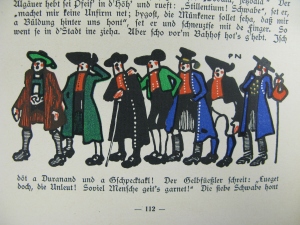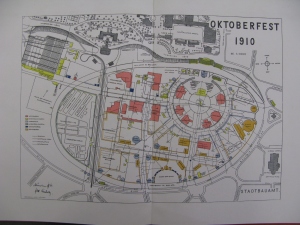
Oktoberfest (also known as Wiesn), is the world’s biggest festival and is celebrated for sixteen days from late September to the first week of October in Munich. This year, the festival’s 181st, ran from September 20-October 5. It was first celebrated when Bavarian King Ludwig I married Princess Therese of Saxe-Hildburghausen on October 12, 1810.
There are a number of books relating to Oktoberfest and related subjects at the University Library, both modern books explaining the history of the festival and its place in German culture, and books from throughout the festival’s history. These include Das Münchener Oktoberfest (Zentral-Landwirtschafts-Fest) 1810-1910 (S570.b.91.1) which describes the history of the first one hundred years of the Oktoberfest, featuring sections on how traditions have been maintained and how they’ve evolved during that time period, and also how the festival is planned. The book includes contributions of writings about the festival (some of which are in Pfälzisch, a German dialect that is spoken in Rheinland-Pfalz Germany). Das Münchner Oktoberfest : Brauchformen des Volksfestes zwischen Aufklärung und Gegenwart / Gerda Möhler (573:01.c.47.100) explains how Oktoberfest’s traditions and practices have developed over the course of its history.

Beer is, of course, the main focus of Oktoberfest. However, only beer that is brewed according to the Reinheitsgebot, sometimes called the “German Beer Purity Law” or the “Bavarian Purity Law” in English, can be sold at the festival. In the University Library’s collections, there are numerous books covering the history of beer industries in Germany, and how regulations such as the Reinheitsgebot evolved, including:
- Münchner Brauindustrie 1871-1945 : die wirtschaftsgeschichtliche Entwicklung eines Industriezweiges / von Christian Schäder. (1999)
2000.8.4086 - Brauen und herrschen : die Görlitzer Braubürger als städtische Elite in Spätmittelalter und Früher Neuzeit / Katja Lindenau. (2007)
573:85.c.200.96 - Bier und Landesherrschaft : das Weissbiermonopol der Wittelsbacher unter Maximilian I. von Bayern 1598-1651 / Karl Gattinger. (2007)
574:4.b.200.5
and - De cervisiis potibusque & ebriaminibus extra vinum aliis commentarius, written by Johann Heinrich Meibom in 1668.
L.4.41
Oktoberfest is of course not only associated with beer. Other elements which are well known to foreigners include traditional food and dress such as Lederhosen, Wurst, Sennerhut and Dirndl. The UL contains a wide range of books on these subjects, such as Die Lederhose in Bayern und Tirol (490:44.c.95.3), a beautiful book describing the details of making Lederhosen and the history. Beer and wurst have long been symbols of German national pride and regional history, as well as reflecting the diversity of each local region in Germany.

Joanne Koehler

